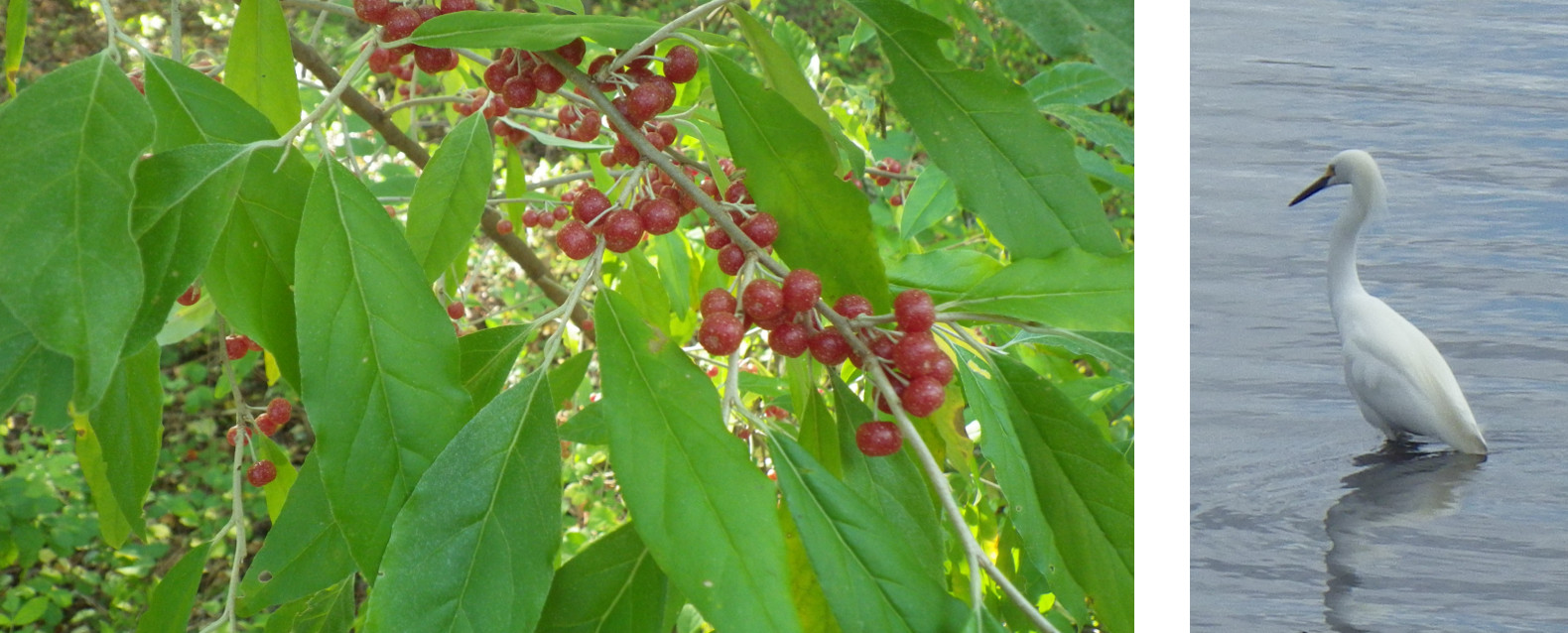By Norman Dudziak, P.E., I.M.
Science Liaison, Barrington Land Conservation Trust
& Sally Johnson, Native Plant Horticulturalist
Owner, ecoastal design
The crown jewel of citizen science for biological nature observations is “iNaturalist,” a social network with over 2.6 million participants. Using iNaturalist, accessible at www.iNaturalist.org, a growing community of citizen scientists is expanding our knowledge about the wild living world by crowdsourcing data collection and identification. “Citizen” in this context is shorthand for “Citizen of the World” and does not relate to legal status.

Norman Dudziak photographed this invasive autumn olive at the Seaview Marsh on October 1, 2020 and this snowy egret at the Aurora Marsh on April 28, 2015 and has posted them to iNaturalist. Both are land trust properties on the Palmer River.
iNaturalist enables you to upload your photos or audio recordings of living things, or evidence of living things, such as photos of animal tracks, along with place and time of observation. If the data are uploaded from a smartphone or other digital device equipped with GPS, the time and exact location of the observation are automatically uploaded.
The truly wondrous part of iNaturalist happens when you click on the “What did you see?” or “Species name” box (depending on whether you are accessing it from a phone or a computer, respectively). At this point, iNaturalist compares your data to the millions of other images previously uploaded by other users.
The artificial intelligence application then returns either a probable species identification or a message saying, “We’re not confident enough to make a recommendation, but here are our top suggestions.” Each suggestion will have “View” link, where you can consider an iconic photo of that species and links to all other photos posted of that species, plus descriptive text and data, which you can compare to your own photo.
Look through the suggestions and, if any looks exactly right, select it. If not, designate the closest taxonomic level of which you are sure. For instance, you may be certain that you have a goldenrod, but have no clue which of the hundred species in that genus you have found, so you label it “Goldenrod.” If you are only sure that you have a plant, it is perfectly acceptable and extremely common to label it “Plant.” Random guessing is discouraged. It is much better to be vague and leave it to someone else with more expertise to narrow it down.
“What? Who would that be?” you may ask. That is the next great feature of iNaturalist, the community of participants. When you post an observation, it becomes visible to anyone on the internet who cares to look.
There are plenty of people whose joy in using iNaturalist is not limited to collecting observations; they also enjoy looking through the observations made by others and making identifications. Many such people specialize in particular biota, which may even be reflected in their username. For instance, I have received some identifications of spiders from a user once known as “harleyfoundaspider.” On your own profile page, you only post as much about yourself as you want. You don’t even need to reveal your real name, if you do not want to.
Another great feature of iNaturalist is that anyone can look at observations posted there without needing to register. Registration is only required if you want to post your own observations or you want to post identifications or comments about someone else’s observations.
The filter function makes it easy to explore iNaturalist. Choose a category of life (plant, insect, fish, etc.), a particular username, an existing project, a place, or other characteristics. Browse and learn as much as you want, all for free. Many people will find it easiest to submit observations on a smartphone using the iNaturalist app. However, browsing the site is best done on a computer, where the photos are bigger and additional features may be available for your use.
With summer fast approaching, you may be itching to get outside. It’s the perfect time to join iNaturalist and start submitting observations, joining the community of citizen scientists. You will provide important data on the geographical range of species and the timing of biological events (phenology), such as when particular flowers are blooming. Using iNaturalist, some people have discovered species new to science or have rediscovered species thought to be locally or globally extinct.
I urge you to check out iNaturalist.org and create a free account where you can make voluntary contributions, entirely on your own schedule, to the body of scientific knowledge.
If you have questions or would like to learn more about citizen science, please email Barrington Land Conservation Trust Executive Director Cindy Elder at cindyelder@blct.org.
About the authors: Norman Dudziak is a retired environmental engineer and the Science Liaison for the Barrington Land Conservation Trust. He communicates directly with scientists who wish to use Land Trust properties for studies or for educational purposes and he encourages people to take part in citizen science.
Sally Johnson is the principal of ecoastal design, a local garden consultancy with a focus on native plants. Both authors are Certified Coastal Invasive Managers (I.M.), as designated by the Rhode Island Coastal Resources Management Council. Contact Program Administrator Kate Venturini Hardesty of URI Cooperative Extension at keventurini@uri.edu to learn more about invasives training and certification. You can also visit their website at https://web.uri.edu/coopext/programs/land/ipmcp/ to learn more about trainings and directly access Management Factsheets for over two dozen invasive plants. All views expressed in this column are those of the authors and are not intended to represent the Land Trust.
